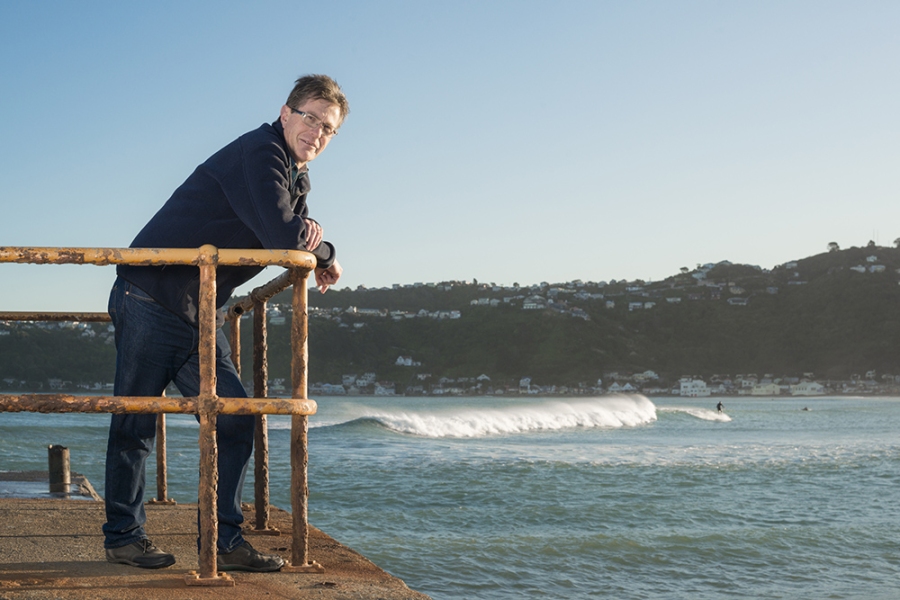Rob Bell is happiest occupying the high ground. With a 35-year career in researching, modeling and monitoring natural hazards, such as king tides, coastal inundation, storms and tsunami, he knows that elevation from coastal margins is the only true protection from a potentially turbulent future.
The 59-year-old coastal oceanographer, who holds a PhD from the University of Canterbury in Civil Engineering, consults extensively on coastal and estuarine environmental projects, particularly the effects of coastal wastewater discharges, dredging, coastal hazards and the impacts of coastal climate change.
Where it all started
Rob’s interest in all things water began growing up in Pareora.
“I grew up in a small coastal village with a river nearby – a wide-ranging backyard to play in and try out activities such as damming small river channels or jumping off the railway bridge.
“Those things got me interested in water, but my initial passion was for mathematics and science at high school. I wanted to build a career on science, but at the same time wanted to be working on practical solutions.”
It was in Rob’s last year at Timaru Boys High School that a career turning point came.
“The best advice I got came from my Year 13 science teacher, a Bachelor of Engineering, who suggested I enrol in Civil Engineering at the University of Canterbury. I specialised in environmental fluid mechanics and did a PhD in riverbed sediment transport in floods, and I haven’t looked back.
“I was fortunate in riding the wave of the 1980s and ‘90s in cleaning up wastewater outfall discharges into coastal waters, particularly driven by tangata whenua. Through these infrastructure projects and an early research project on tidal mixing, I learned coastal oceanography on the hoof through books, computer modeling and lots of field work at amazing coastal areas, observing the processes first-hand.”
“I also had a very unique opportunity to learn about the destructive power of tsunamis, when I went to Thailand after the devastating Boxing Day tsunami in 2004.”
While he has no plans to wind his career down just yet, he’s happy to be passing his knowledge on to the next generation of scientific thinkers and leaders.
“I’m still in my first real job, starting out with a core group of scientists and engineers, some of whom are still working. That has been hugely satisfying, along with partnering with clients to complete successful but challenging projects.
“Most rewarding is being part of the value chain in translating science and its uncertainties into policy, guidance and engineering design, where it makes a real difference on the ground, and sharing my experience with younger staff through mentoring.”
Balancing act
While work at NIWA in Hamilton keeps him busy, Rob makes a point of achieving balance through spending time and holidays with wife Ruth, listening to music (jazz, gospel, and rhythm-and-blues are his favourite genres), gardening and visiting his adult children and grandchildren.
“We make regular visits to family in Auckland and the ‘grandies’, bike rides (recently the Otago Central Rail Trail), church activities, reading and summer camping at the beach (usually Ohiwa, in the Eastern Bay of Plenty) to get a dose of sea air. I also enjoy woodwork and woodturning when I can access a lathe.”
Travelling is another passion – and water features prominently in most of the places he has visited.
“I love Canada – I spent an amazing three months on sabbatical at the Institute of Ocean Sciences near Victoria on Vancouver Island. Next on the list is cruising Canada’s Inside Passage and Alaska before the glaciers melt much more.
“I enjoy big cities as well – my sister-in-law lives in Austria with a flat in Vienna. I’m intrigued with the canal cities of Venice, Copenhagen and Amsterdam and I recently soaked up Berlin in the weekend while on a work visit in May.”
Giving back
Rob uses his scientific knowledge, expertise and experience to seek out ways to make the world a better, more sustainable place for future generations.
He and Ruth, an advocate coordinator for TEAR Fund, a Christian international aid and development agency, raise funds through Gift for Life to support micro-enterprise projects, and five children in Africa, the Caribbean and India.
“The TEAR Fund were early observers of the detrimental impacts of climate change on agriculture, and advocate spending money on sustainable risk reduction, rather than just continually responding in the aftermath of disasters.
“Sustainability of our world for my grandchildren and beyond – that’s a forward challenge at our current consumption and emission rates. We need to learn to adapt and work with nature, and include water and the sea in our thinking, rather than fighting it.”

